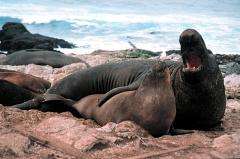November 13, 2009 weblog
Elephant seals take naps while diving

(PhysOrg.com) -- A new study may have solved the long-standing question of how elephants sleep during their long migrations at sea, when they can be away from land for up to eight months.
Whales and dolphins are believed to be able to sleep at the surface by having one hemisphere of their brains asleep while the other remains awake, but northern elephant seals (Mirounga angustirostris) cannot do the same, and they rarely spend much time at the surface. Scientists have therefore wondered how these animals can sleep during their migrations from the Californian breeding colonies to feeding areas around Alaska and the mid-Pacific. Now a new study suggests they may sleep underwater as they slowly sink.
The team of researchers from the US and Japan fitted six young northern elephant seals from the seal colony at the A?o Nuevo State Reserve in California with data loggers. The instruments recorded the speed, depth, temperature, location and three-dimensional movements of the seals and allowed the scientists to model their dives in three dimensions. The seals were released up to 70 km from their colony and then tracked as they made their way back home.
The results of the study showed the seals made the same kind of repetitive deep dives as they are known to make during their migrations. They also found the seals sometimes roll over and then spiral down towards the bottom of the sea in a slow descent known as the drift dive.
According to Russel Andrews, one of the authors of the paper, the periodic wobbling associated with the drift dive resembles the fluttering of a leaf falling to the ground, and slows down the rate of descent. The scientists believe the seals use the long dive to rest, process their food, and possibly even sleep. The depth of the dive (800 m or more for males and 600 m for females) also reduces the risk of attack by predators.
The northern elephant seal migrates twice a year between the breeding colonies in California and Mexico and feeding grounds in the north Pacific. The males head for the Gulf of Alaska and the Aleutian Islands, while the feeding grounds used by adult females are further south. Elephant seals are the only animals that migrate biannually, and they spend between 250 and 300 days a year at sea, and travel up to 21,000 km.
The paper was published in the Royal Society's Biology Letters.
© 2009 PhysOrg.com
















